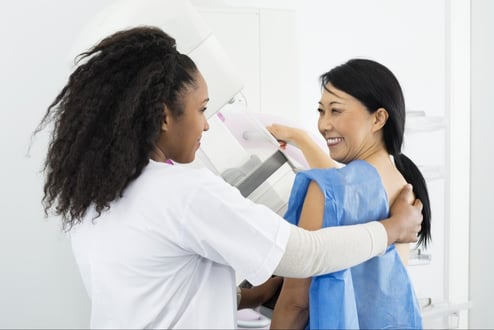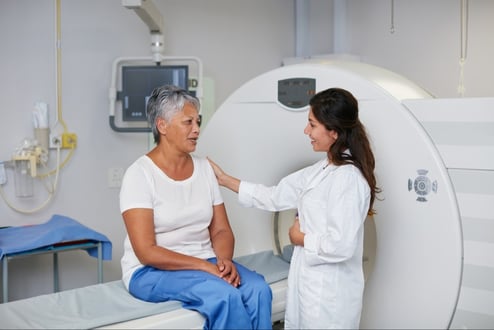Early Detection of Breast Cancer
What is breast cancer screening?
Screening for breast cancer uses tests to try to catch cancer in its early stages, when it is most treatable. The earlier that cancer is found, the better a person’s chance of surviving it.
Who should be screened for breast cancer?
There are guidelines for breast cancer screening for all women, and some high-risk men. Recommendations on who should receive which breast screenings depend on several factors, including:
- age
- gender
- whether you are currently pregnant or breast feeding
- personal risk for breast cancer based on family history, presence of an inherited gene mutation or other factors
- breast density, or other findings from previous breast screenings
Read below for more information about the different types of breast screening and guidelines for high-risk and average-risk people.
Types of breast screening
The sections below outline the most common types of breast screening.
Breast exams, breast awareness and breast cancer symptoms
Breast exams involve feeling the breast tissue for lumps or other changes that might be cancer.
- During a clinical breast exam () the doctor or nurse carefully feels the entire breast to find lumps or other abnormal changes.
- A breast self exam () involves a person checking their own breasts on a monthly basis to look for abnormalities. is no longer recommended for women by some organizations, but others continue to recommend since many cancers are initially found this way. Experts recommend training high-risk men to perform .
- Breast awareness is a term that highlights the importance of people knowing what normal breast tissue should feel like and reporting any changes or abnormalities in their breasts to their doctors. Similar to a breast self exam, breast awareness requires people to check their breasts at regular intervals. Ask your doctor to explain what you should look for and when to report changes.
- Some of the symptoms of breast cancer are listed below. Importantly, these symptoms do not mean you definitely have cancer. Also, many breast cancers don't cause any symptoms. Report any of the following to your doctor:
- a lump or abnormal mass in the breast
- breast swelling
- dimpling or puckering of the skin of the breast
- changes in the nipple (turning inward, red, thickened, dry and flaking)
- nipple discharge (other than milk)
-
swelling of the in the armpits or collar bone area
use xrays to look at the breast tissue. , like other xrays, expose people to a small amount of radiation. They are considered safe for most women, however experts recommend that women who may be sensitive to radiation should avoid and use breast MRIs instead. This group includes women under the age of 30 and women with certain inherited mutations, such as . is the most commonly used screening tool to detect breast cancer. find cancers in women of all ages, however, are less effective for women with dense breast tissue. You can read more about breast density and how it's measured and reported in the article on the right. For women with dense breasts, or may find cancers that were not seen with .
3-D ()
Breast , also known as 3-D , uses xrays to take a series of images that give a layer-by-layer, 3-dimensional picture of the breast. Because of this, 3D may find cancers earlier than traditional . They are also less likely to give a "" result, when a person is called back for an abnormality that turns out not to be cancer. The radiation exposure from is small, and does not increase the risk for breast cancer.
Breast
Breast Magnetic Resonance Imaging () is an imaging method that uses magnetic fields rather than xrays to produce a detailed picture of the breasts. is sensitive and may pick up an abnormality not seen by other imaging tools. For this reason, is recommended for women at high risk for breast cancer. There is also a greater chance for to find changes that need a biopsy, but end up being benign (not cancer). These are known as "" results.
exams that look for cancer require the injection of a contrast agent called gadolinium. The contrast helps doctors spot breast abnormalities more easily. There is some concern that with repeated use during yearly breast screenings, gadolinium could build up in the brain. Researchers are studying whether this buildup is harmful to some people. At the moment, most experts have concluded that the benefit of using contrast agents for breast MRIs in high risk women outweighs the small possible risks. Newer agents are available that may cause less buildup in the brain. It is important that you talk with your doctor about the risks and benefits of annual with gadolinium contrast.
uses sound waves to image the breast. may be used to find cancers in women with dense breasts, which can hide cancer on a . is painless, uses no radiation and is widely available. is less sensitive than breast and therefore is not usually used for screening high risk women who already receive yearly MRIs.
Visit our Partner

In the News
Guideline : What is breast density and why does it matter?
New FDA guidelines for mammograms will go into effect by...
Study : Yearly breast MRI screening improves outcomes for women with inherited BRCA mutations
An international research study of yearly breast MRI screening among...
Breast screening guidelines
National guidelines recommend who should consider breast cancer screening, which screening options are most appropriate and at what age screening should start. These guidelines vary based on gene mutation, family history and other factors. Breast cancer screening guidelines are different for people at high risk and average risk. See below for more information and talk with your doctor to decide which screening and schedule is right for you.
Screening for high-risk women
The National Comprehensive Cancer Network (NCCN), is an organization of cancer experts that creates guidelines on cancer care and updates them yearly. They create separate guidelines for women at increased risk for breast cancer due to inherited mutations or other risk factors. Screening guidelines for high risk women usually includes a combination of breast exams, 3D and breast MRIs, often beginning at age 25. You can find information on screening guidelines for specific gene mutations linked to breast cancer here.
|
Screening |
Beginning Age |
|
Breast awareness
|
No set age. This applies to people with a mutation in the following genes:
|
|
Clinical breast exam
|
Age to begin depends on the gene:
|
|
Breast
|
Age to begin depends on the gene and family history (for families with members who had breast cancers diagnosed before the recommended screening age, screening may begin earlier):
|
|
|
Age to begin depends on the gene and family history (for families with members who had breast cancers diagnosed before the recommended screening age, screening may begin earlier):
|
|
Source: NCCN Guidelines: Genetic/Familial High-Risk Assessment: Breast, Ovarian, Pancreatic, v. 3, 2025. |
|
|
Recommendation |
Beginning Age |
|
Learn how to do a breast self-exam and be aware of changes in your breasts. |
35 |
|
Breast exam by doctor every 12 months. |
35 |
|
Have a discussion with your doctor about the benefits, risks and costs of annual . |
50 (or earlier based on the youngest case of male breast cancer in the family) |
|
Source: NCCN Guidelines: Genetic/Familial High-Risk Assessment: Breast, Ovarian, Pancreatic, v. 3, 2025. |
|
Paying for high-risk screening
The federal Affordable Care Act requires most health insurance companies to pay for annual for women 40 and older with no out-of-pocket costs. High-risk women are recommended to have additional breast screenings such as , starting at a younger age. Many states have laws requiring coverage of these “supplemental” screenings and other health services for individuals at increased risk of cancer. Visit our page on on high-risk breast screening coverage.
Despite federal and , some health plans still deny coverage for high-risk screening or charge large out-of-pocket fees. You can file an appeal with your health plan. Visit our page with tips for filing an appeal and our page with sample appeal letters.
For people with or without insurance who cannot afford high risk screening, the 's National Breast and Cervical Cancer Early Detection Program provides each state with funding for low-cost breast screening. For some states, but not all, this includes funding for breast for people who meet the guidelines. Visit their page for more information about low-cost screening in your state.
Federal laws and most do not cover breast screening for high-risk men. This means that high-risk men may need to pay out-of-pocket costs for high-risk screening.
|
Organization |
Age to Start / Type of Screening |
Additional Notes |
|
|
National Comprehensive Cancer Network (NCCN) |
Age 25:
Age 40:
|
Starting at age 25, women should speak with their doctors about their risk of breast cancer. Breast cancer risk assessment includes discussion about family history of cancer and other risks factors. |
|
|
American Cancer Society |
Age 40
Ages 45 - 54
Ages 55 - and older
|
Screening should continue as long as a woman is in good health and is expected to live at least 10 more years. |
|
|
United States Preventive Services Task Force |
Age 40
|
Screening should continue until age 75. |
|
What happens when an abnormality is found on breast screenng?
If a breast lump is felt on exam, doctors will usually order diagnostic testing to see if the lump is cancer. This may include , , (a test that uses sound waves to look more closely at breast tissue) and a biopsy. Abnormalities found on or may require additional imaging or a biopsy.

